At TUNE we’ve published nine major app store optimization reports over the past six months. Now we’re taking the best tips from each one and sharing them with you here.
If you need more information, or full context, get the full reports. They are completely free in all cases, and you can subscribe to all of them right here:
TIP #1: Enable Spotlight search on iOS
Get more engagement by enabling Spotlight search in your iOS apps. One popular entertainment app with about two million iOS installs saw a significant increase in daily opens and active users from Spotlight search.
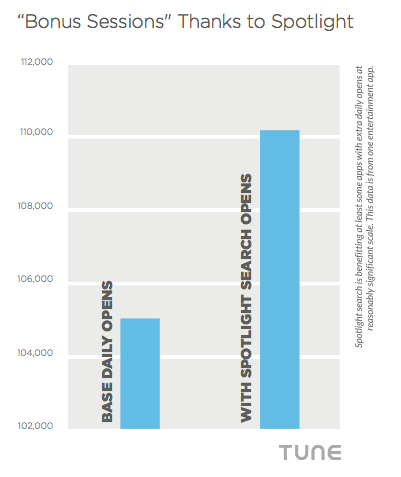
TIP #2: Switch categories to win
Pick categories in which you can win. As Gilad Bechar of Moburst told me, “switching to a category where you might have less competition can make a huge difference.” Example: Twitter switching from Social to News, where it instantly became number one.
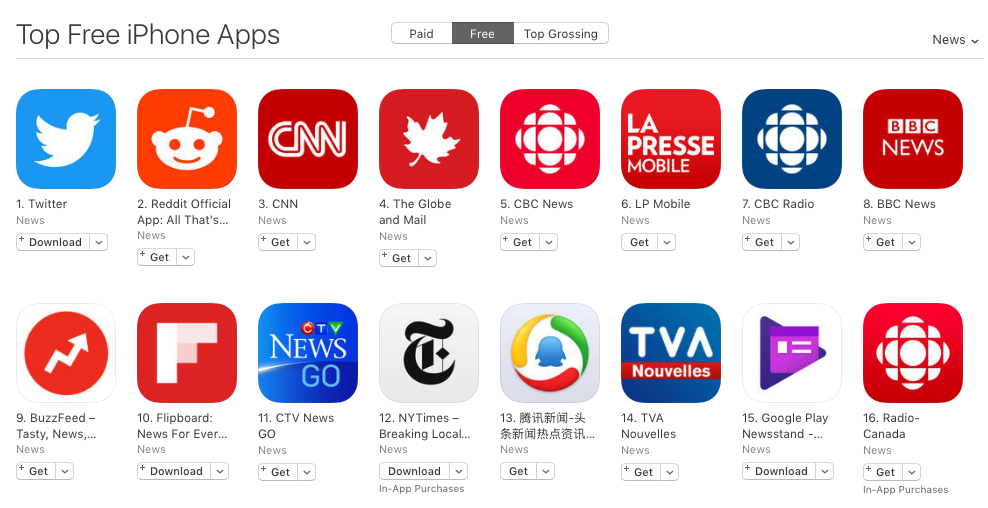
TIP #3: Enable Firebase App Indexing
Boost user acquisition and re-engagement by enabling Google’s app indexing.
We’ve seen session growth from 10-20% for already-on-device apps, plus user acquisition growth, particularly in data-rich vertical search apps.
TIP #4: Ratings are table stakes (but you still need them)
iOS apps in the top 150 per category average 3.81 stars with only 0.6 variance. Apps in the top 240 per category on Android average 4.16, with just .3 variance. Clearly, you need top ratings to get in the upper echelon of the app stores.
But … once there, they will no longer differentiate you. iOS developers note: iOS 10.3 will allow you to prompt users to review in-app … but only for a few times a year.
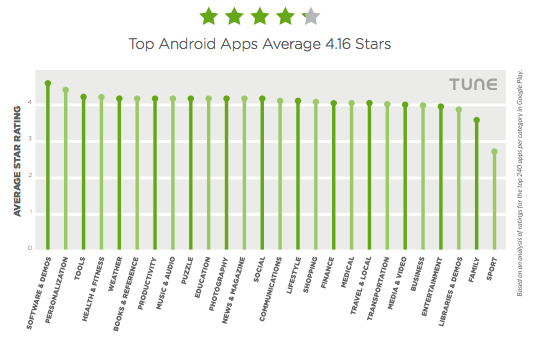
TIP #5: Get more ratings than your competitors
You have to know who you’re fighting, and you have to know their assets. And even though ratings are table stakes, you have to achieve similar or better volumes than your competitors.
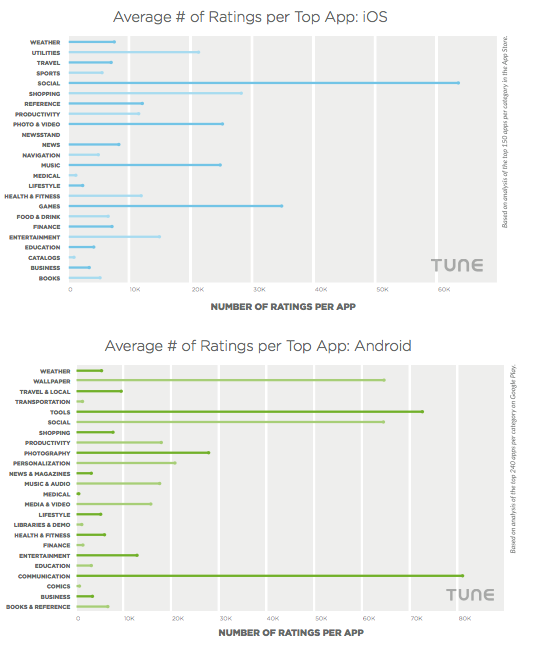
TIP #6: Get guaranteed 4-star ratings
Ratings are being gamed by the big apps, and your only defense is to game them right back.
In the App Store, 65 percent of all ratings are five stars, and almost 80 percent of all ratings are either four or five stars. On Google Play, 68 percent of all ratings are five stars, and 83 percent of all ratings are either four or five stars.
How? Use in-app messages to ask users how happy they are with your app, and if they’d be willing to rate it. Send the happiest ones to the App Store or Google Play; improve the things the unhappy ones complain about.
But beware: Apple is starting to try to limit the number of times you can ask your users for reviews.

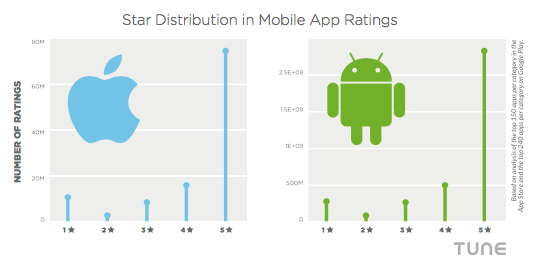
TIP #7: Engage your users
Google and Apple keep track of app abandonment and deletions. And that data matters.
As Shawn Jones of CarAdvice told me, “You want your users to keep your app installed as long as possible and use it often. If your app gets a lot of downloads but people uninstall it quickly, that will negatively impact your ASO.”
TIP #8: Search keyword volume, relevance, and difficulty
Know how much volume keywords are getting before you choose which keywords you want to win. Winning a high-volume keyword could be hard but rewarding; winning a low-volume keyword could be easy but useless.
But keywords with extreme relevance are worth fighting for, even when it’s difficult. (Note: TUNE’s own App Store Analytics enables keyword volume searching.)
TIP #9: Build your offline/online/social footprint … AKA “brand”
70 percent of people have seen or heard of an app at least once prior to installing it. For almost a third, they’ve seen or heard about it more than three times. And top 50 apps average 5.3X more Google results and 5.5X more Facebook followers.
The upshot: build your brand recognition outside of the app store for better in-store conversion optimization.
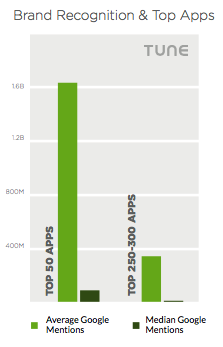
In addition: 86% of the top 100 App Store keywords are branded.
TIP #10: Go big or go home
Apps are a winner-takes-almost-all ecosystem. That doesn’t mean niche players can’t succeed, or that they can’t be successful in their own right. But it does mean there are outsized rewards for leaders.
The top 10 iOS apps account for 83% of all installs, and the top 10 Android apps account for 80%.
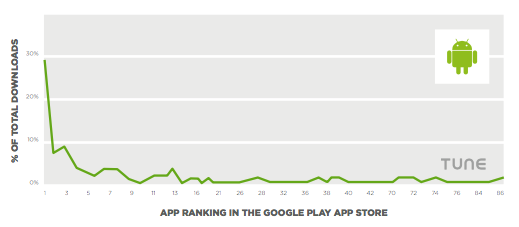
TIP #11: Use paid installs to juice organic installs
Organic is really, really critical, because 65-70% of all app installs are organic. But paid app installs boost organic installs by 1.5X across the board … and, in some categories, the boost is as high as 17X.
So boost organic with a little paid.
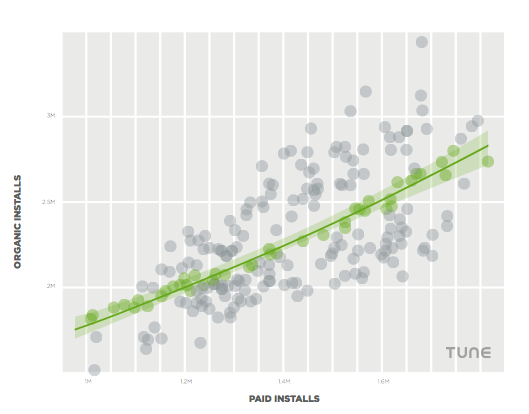
TIP #12: Optimize your app listing conversion rates
Use Google’s tools and third-party App Store tools to optimize conversion on your app listings. 65-70% of installs originate via app store search, so an ounce of optimization adds a pound of installs. And might mean the difference between profitability and failure.
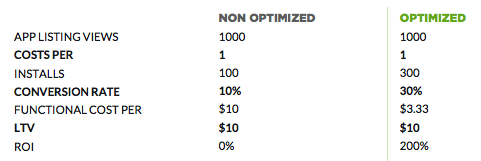
TIP #13: You solve a problem? Show & tell
Just over half of all app installs are motivated by a specific, goal-oriented, purposeful hunt for a solution to a problem, need, or want. In app descriptions, clearly highlight your solutions. In screenshots and your app video, quickly show what you do.
And … know how people make app download decisions.
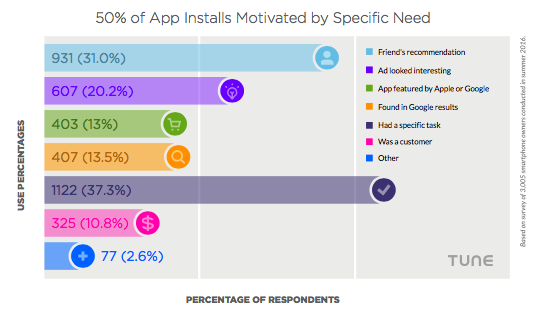
TIP #14: Targeting women? They check reviews
If your app focuses on a female audience, ensure you have great reviews with clear usage stories. These are great for men too, but they’re especially valued by women.
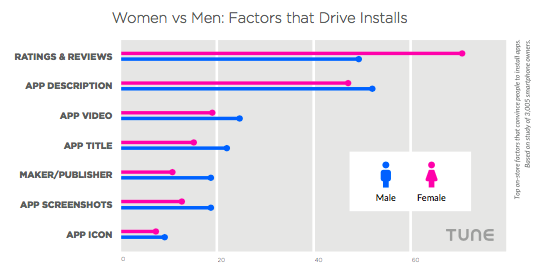
TIP #15: Be topical
Launch your watersports app when there’s a major competition or event, and let the hype carry your app to success.
As Flynn Zaiger of Online Optimism told me, “pushing out an Olympics or Rio themed app during the Olympics would greatly increase the effectiveness of your launch. Not only are more users searching for these kinds of apps during this time, but the app stores feature lists that are likely to include your app if they see it coming down the pipeline. This makes it the perfect time to get that ranking boosts.”
TIP #16: Make an app video
Not only do apps with videos rate higher, app videos are a critical part of the download decision. In fact, 40% of smartphone owners say that app videos are one of their top three considerations when deciding whether to install an app.
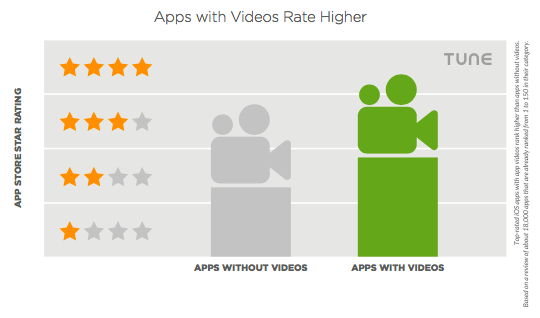
TIP #17: Win search by winning keyword ranking
65-70% of installs happen via app store search. Your app has to rank for between 15-25 search terms in order to crack the top 150 apps in your category on Google Play.
On the iOS App Store, you have to rank for more than 25 to crack the top 150, and to hit the top 10 you have to rank for over 65 terms.
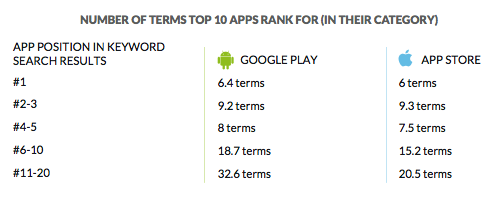
TIP #18: Know all 22 of the major ASO ranking factors
METADATA YOU SUPPLY
- Title of your app
- Description of your app
- Publisher name (does it include keywords, for instance)
- Keywords for your app (iOS)
- Category you select
- App video: do you have one or not
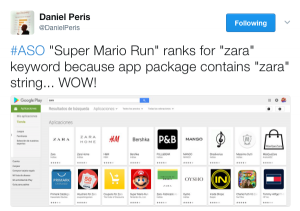
This may not last for long …
APP DATA
- Size of app
- Localization: is your app localized?
- Bonus: App package string keywords (Android only)
ON-STORE DATA
- Installs
- Views of your app listing
- Conversion ratio of views to installs
- Install velocity over time (and especially recently)
- Searches for your app
OFF-APP STORE DATA (MOSTLY FOR GOOGLE PLAY)
- Links to your app/website
- Prominent mentions on top websites
- Social mentions
SPOTLIGHT SEARCHES AND TAPS/CLICKS (IOS)
IN-APP USAGE DATA
- Number of active users
- Time in app
- Average revenue per user
- App abandonment ratio
- App deletions
USER RESPONSE
- Ratings of your app
- Reviews of your app
- Quality of your ratings & reviews
TIP #19: Keep priming the pump
Paid acquisition bursts are fine, but you risk losing many of the benefits if you only advertise in bursts.
As Alex Walz, who leads growth for Lighter Capital, says, “I see this all the time with retailers who invest in advertising blitzes to promote their mobile apps, resulting in their apps jumping from #830 in the top charts to five. These gains, however, are fleeting as your rank will drop the moment you pull back on ad spend. Real, sustainable ASO requires solid metrics.”
TIP #20: Targeting teens? Marketing works
Teens are more influenced by marketing than any other age group: more than 30% of them install apps for ads they’ve seen.
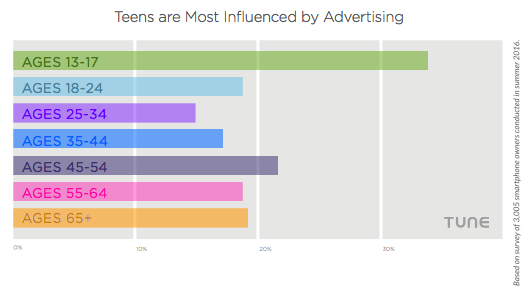
TIP #21: Increase user engagement and limit app abandonment
When people delete your app after a minute or two, that reflects poorly on your ASO.
“Ever download an app and try it out and realize it was a waste of your time and then immediately delete it?” asked Bryan Clayton, CEO of GreenPal. “Well, in doing so that negatively affects that app’s rankings in the store you got it from.”
To get all of the reports with even more tips …
To get all of the reports with even more tips, you know what to do — click the image below. If you just want a prettier PDF version of these 21 tips, you can have that too.
Author
Before acting as a mobile economist for TUNE, John built the VB Insight research team at VentureBeat and managed teams creating software for partners like Intel and Disney. In addition, he led technical teams, built social sites and mobile apps, and consulted on mobile, social, and IoT. In 2014, he was named to Folio's top 100 of the media industry's "most innovative entrepreneurs and market shaker-uppers." John lives in British Columbia, Canada with his family, where he coaches baseball and hockey, though not at the same time.

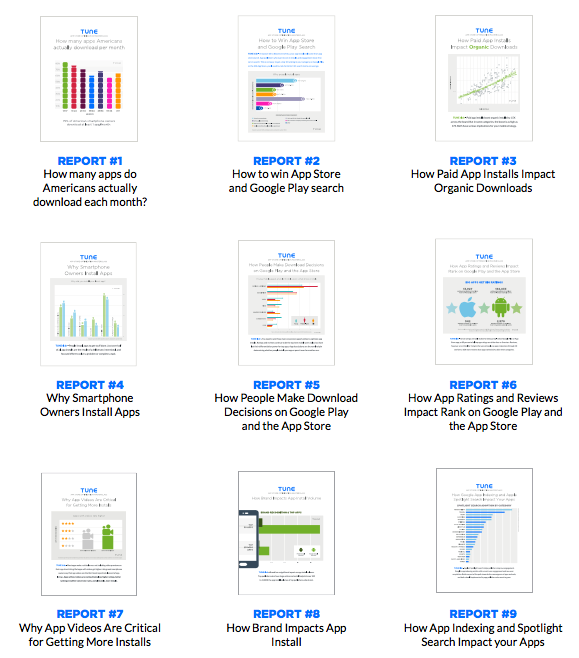

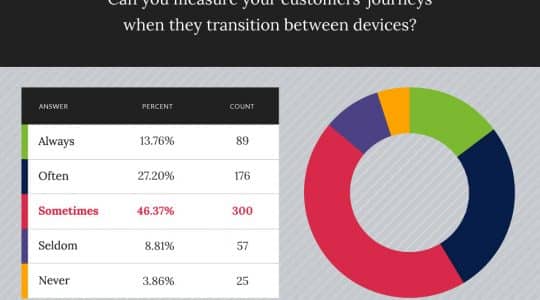

indeed useful article. Thank you so much for sharing these tips.